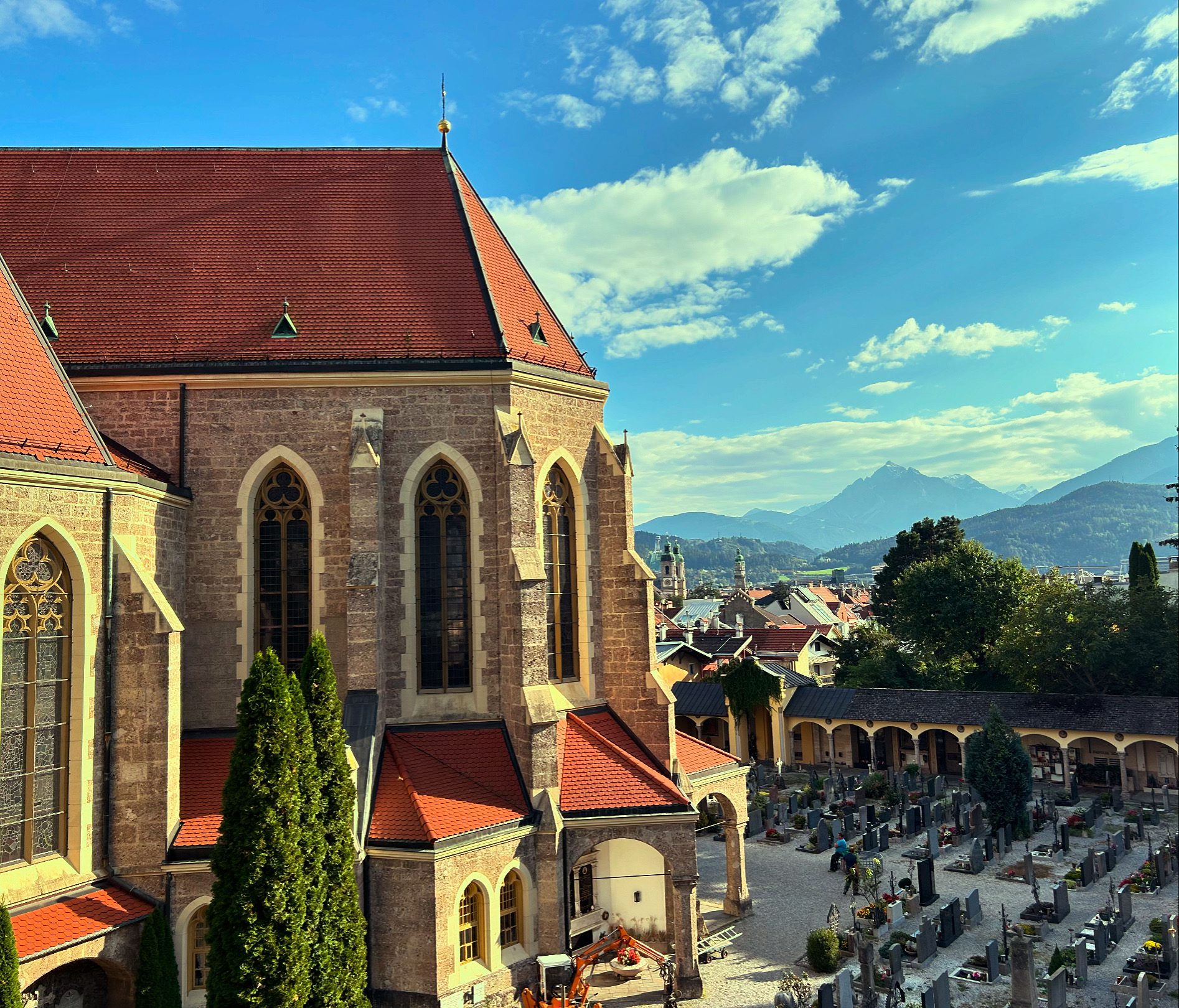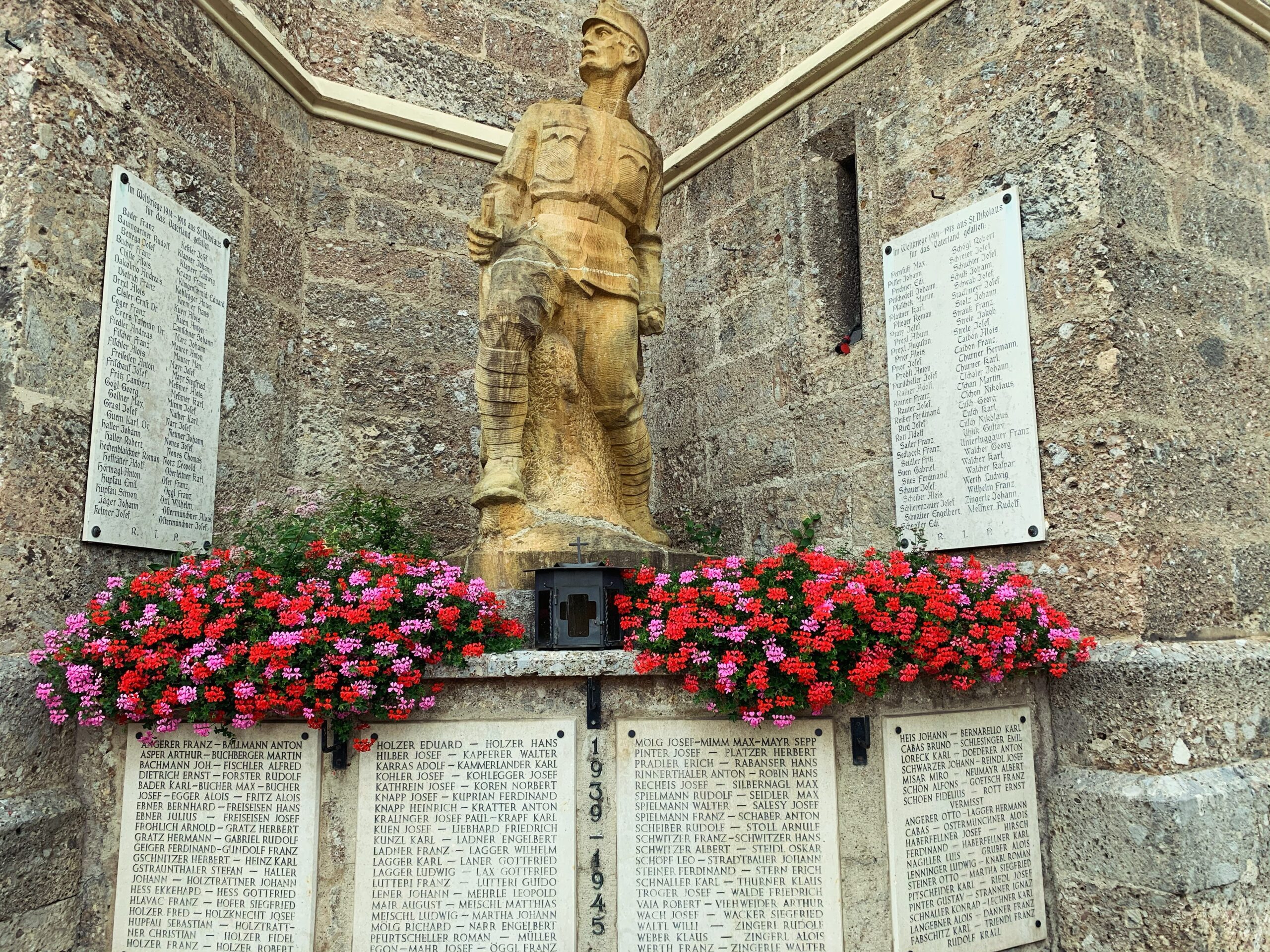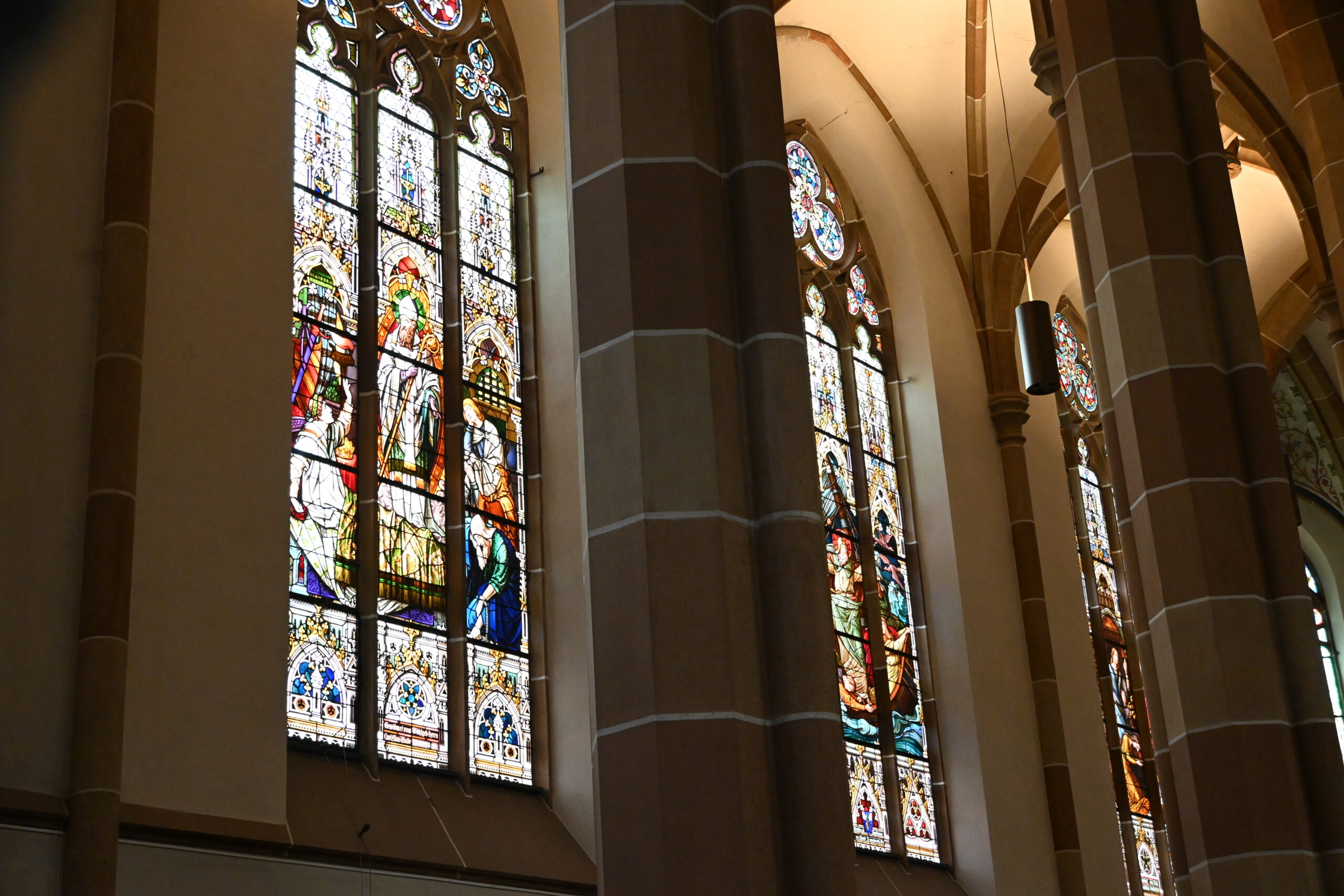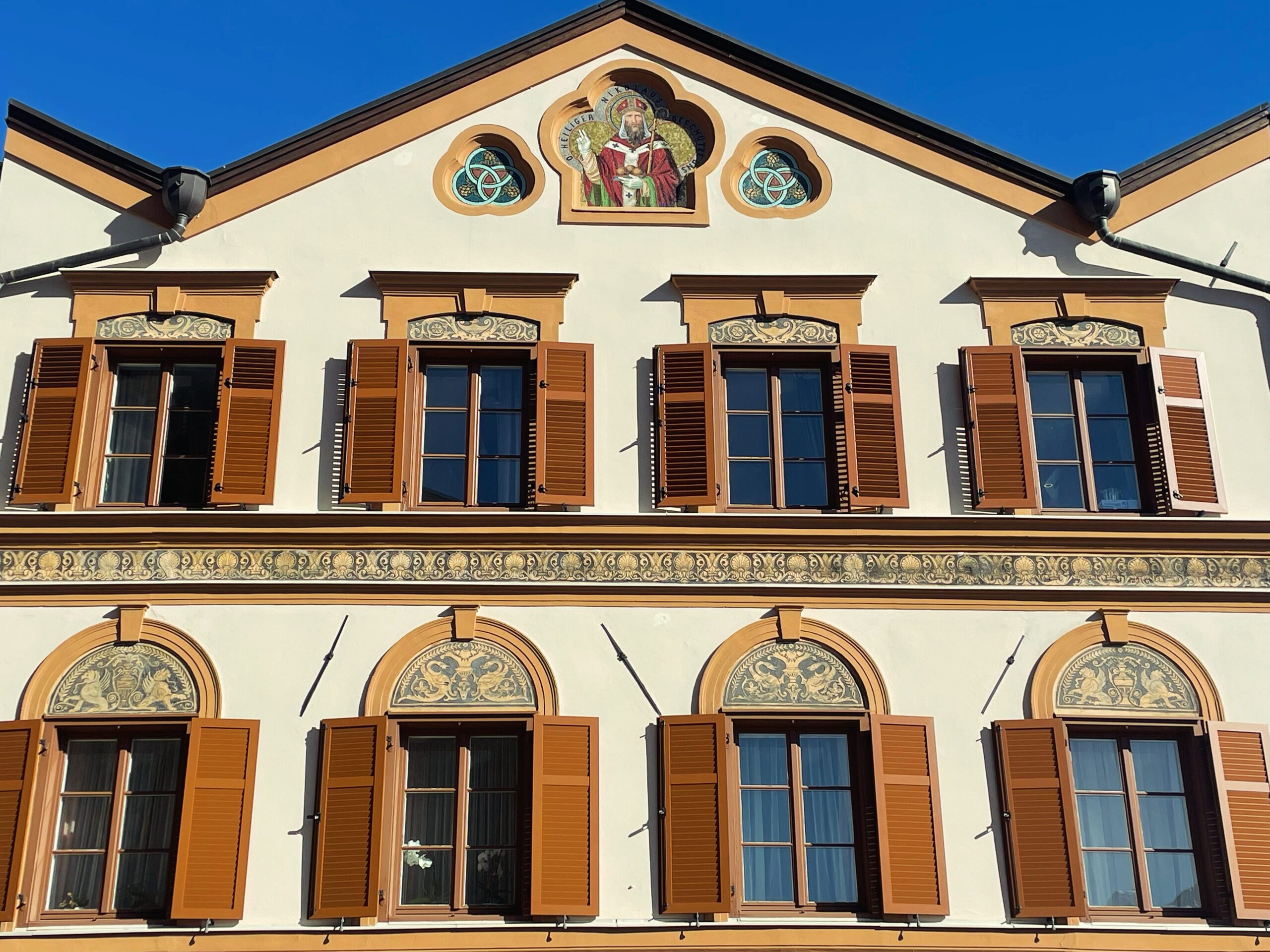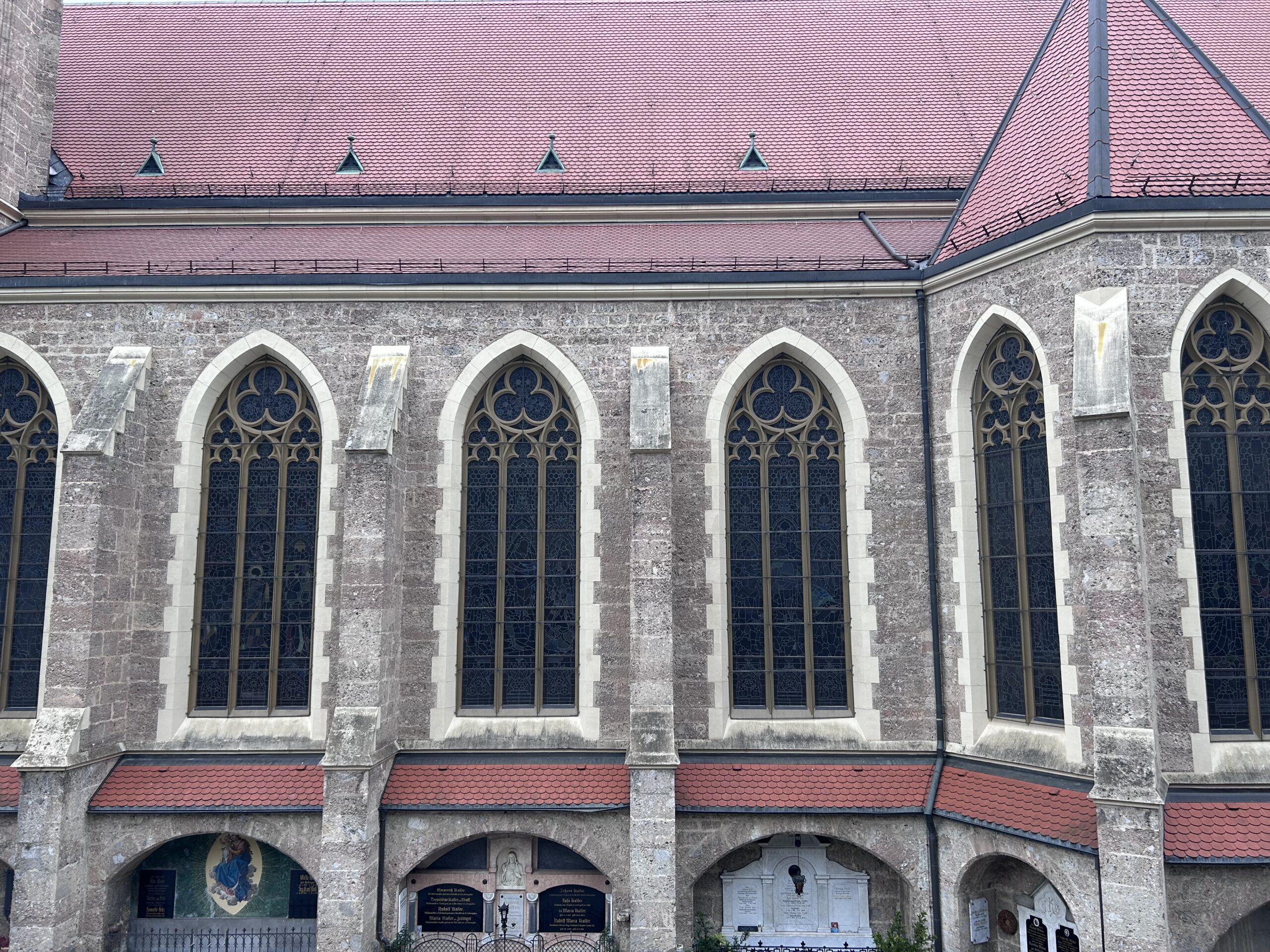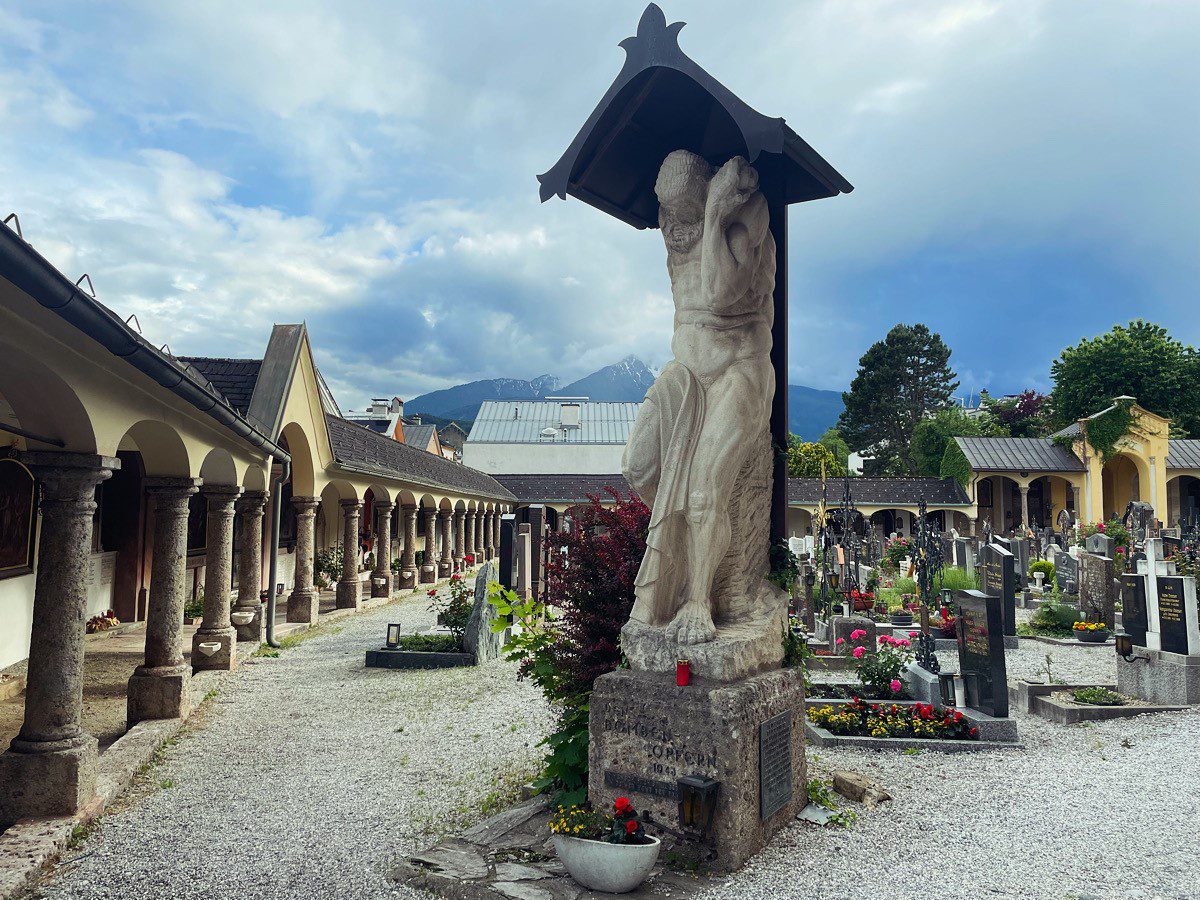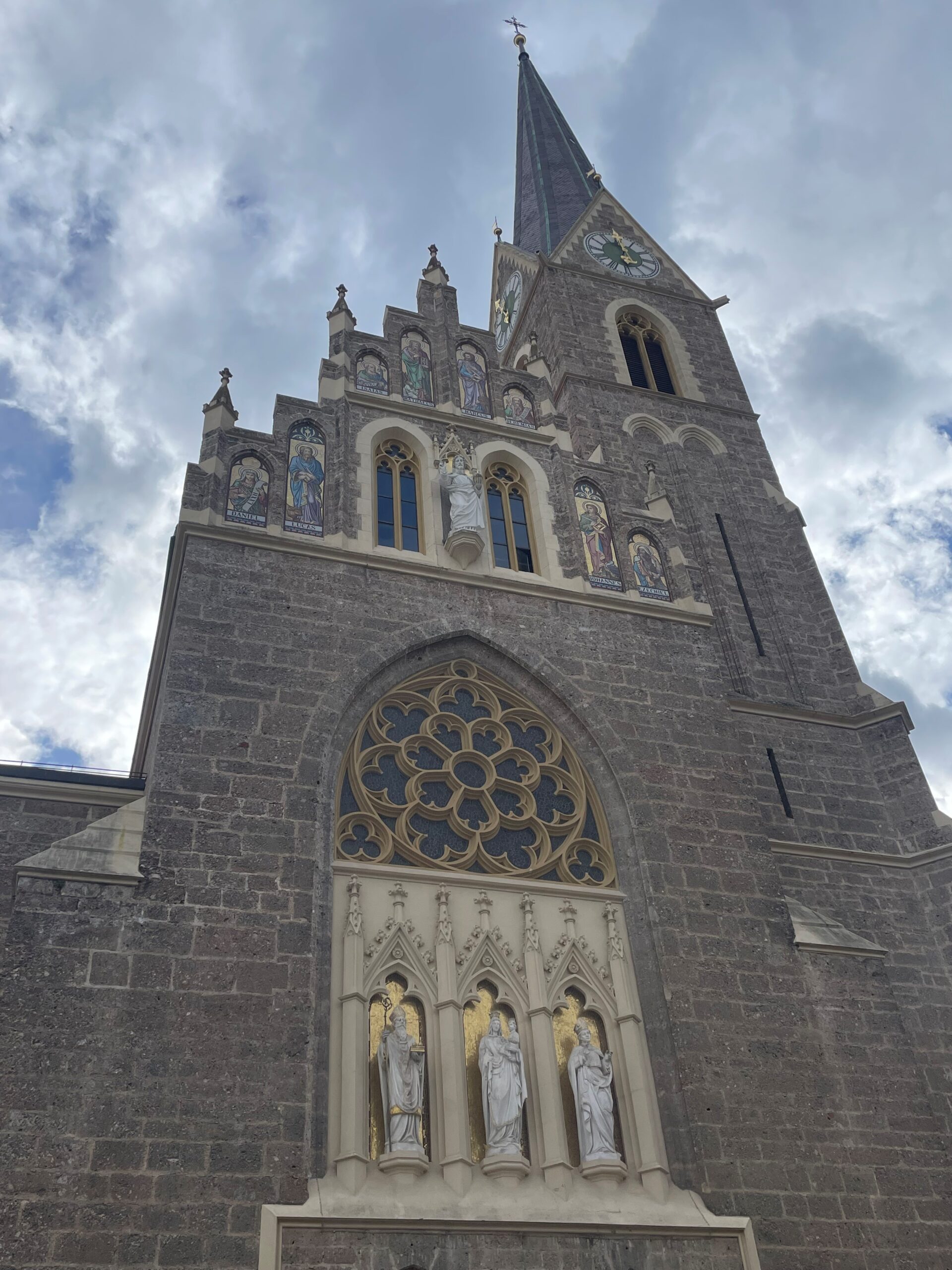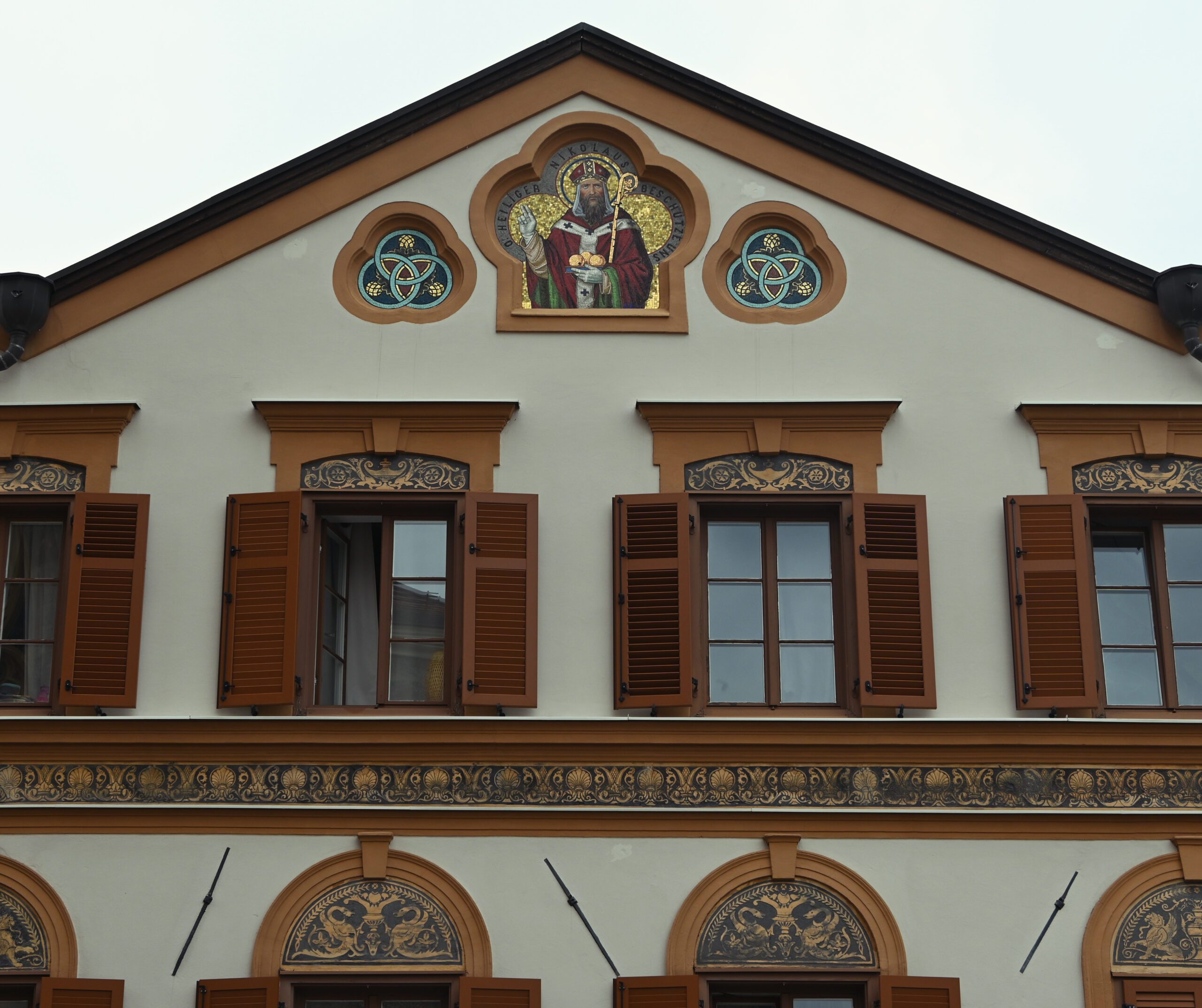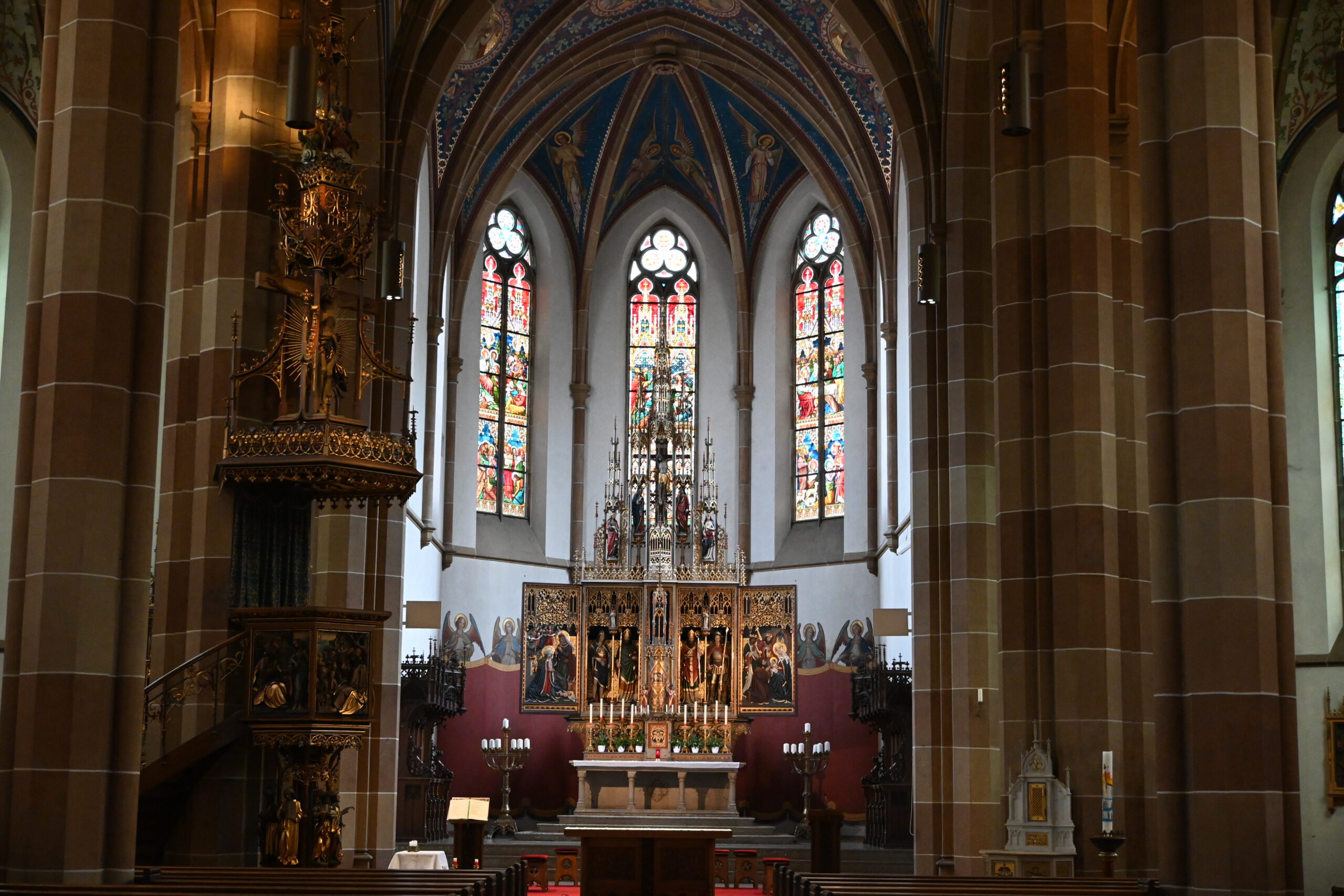Kirche & Friedhof St. Nikolaus
Schmelzergasse 1
For those in a hurry
- As early as the 16th century, there was a chapel and cemetery near the infirmary dedicated to St Nicholas, a popular saint, especially among the poorer sections of the population, and patron saint of thieves and prostitutes.
- Until 1789, there was a special "Siechenhaus" nearby for people with infectious diseases and physical disabilities, whose community of "Sondersiechen" was organised by begging. The begging rules in Innsbruck were regulated by a "Siechenvater" (father of the sick) and a "Siechenmutter" (mother of the sick), who acted as a kind of representative body. A building opposite the church still bears an image of St Nicholas today.
- In 1851, the church was elevated to its own parish due to the rapid growth of the community during industrialisation.
- The new neo-Gothic church building (1882-1886) was designed by the Viennese master builder Friedrich Schmidt, who was also involved in the Vienna City Hall and St Stephen's Cathedral and created the Rudolfsbrunnen in Innsbruck.
- The architectural style of the church with its steeple, pointed arch windows and figures is reminiscent of the Middle Ages and is a typical example of the neo-Gothic style of the Austro-Hungarian monarchy, which produced similar sacred and secular buildings in many crown lands.
- Inside the church, the organ, the ribbed vault with paintings of saints and depictions of Old Testament prophets and New Testament evangelists are worth seeing. A side altar from 1906 is dedicated to the veneration of the Sacred Heart and symbolises the Tyrolean oath of 1796. A war memorial commemorates the fallen of the First World War.
- In the Middle Ages and early modern times, the cemetery surrounding the church was the resting place for the poor of the infirmary and the executed from the nearby Köpflplatz.
Worth knowing
The parish of St. Nikolaus is closely associated with the history of the Innsbruck district, which was long known as a poor neighbourhood just outside the city gates. Until 1789, St. Nicholas was home to the Special Sickhouse, where people with infectious diseases and physical deformities were housed far from the city. The first mention of this institution dates back to 1313, when the citizens' hospital was located in the suburbs and the infectious sick and the socially most vulnerable in society were kept further away from the centre. The Sondersiechen waren eine als Bettlergilde organisierte Bruderschaft, die sich durch Betteln und Almosen organisierten. Das Betteln in Innsbruck wurde durch eine eigene Ordnung geregelt. Den Vorstand bildeten der Siechenvater und seine Frau die SiechenmutterThe latter acted as a kind of representative body to the outside world and organised daily life on the inside.
From the 16th century onwards, there was also a Special screen house a chapel with a cemetery. It was dedicated to St Nicholas, who was one of the most popular saints, especially among the poorer sections of the population. St Nicholas of Myra, who is the subject of many legends, was chosen as the patron saint not only by many craft guilds, but also by thieves and prostitutes. He fitted in with the Koatlacknthe neighbourhood where the penitentiary, execution site, workers and beggars were to be found. The veneration of saints as an expression of popular piety, which was criticised as superstition by Enlightenment philosophers and Protestants, was particularly widespread among the poorest. The Handl's house opposite the church has a mosaic depiction of St Nicholas on the gable in an orthodox style, one of the first works by Albert Neuhauer's mosaic studio. The three golden spheres symbolise the story of the three rescued virgins, whose father was only able to pay his daughters' dowries with the help of Saint Nicholas, thus saving them from the fate of ending up as prostitutes.
In 1851, St Nicholas was elevated to its own parish. The parish had grown rapidly during industrialisation and the old chapel had become too small. Between 1882 and 1886, the construction company Huter & Söhnewho already have the Monastery of Perpetual Adoration had built the church. The design came from the Viennese master builder Friedrich Schmidt (1825 - 1891). Schmidt was a professor of medieval architecture at the Academy of Fine Arts in Vienna and was also responsible for the construction of Vienna City Hall and St Stephen's Cathedral, where a memorial plaque commemorates him. In Innsbruck, he designed the Rudolfsbrunnen fountain as well as the church of St Nicholas. Schmidt characterised the neo-Gothic style of the Austro-Hungarian monarchy. Between 1870 and the First World War, sacred and secular buildings in a similar style were erected throughout the empire between Innsbruck in the west and Galicia in the east. These highly recognisable buildings still characterise the townscape of many former crown lands today. The similarity between church and government buildings created a link between the two dominant organisations of the time, the monarchy and the church.
The church tower, the pointed arched windows, the figures of St Martin, St Nicholas and Mary and Child above the entrance, the façade, the windows - everything is stylistically reminiscent of the Middle Ages. The church's Tyrolean Glass Painting and Mosaic Institute designed and manufactured windows are true works of art. When the sun shines, they flood the imposing ribbed vault decorated with paintings of saints. The eight mosaics on the façade were also created by the Wilten artisan workshop. They depict the four evangelists of the New Testament as well as the prophets Daniel, Ezekiel, Isaiah and Jeremiah. In 1906, an altar was built in a side aisle for the Herz-Jesu-Verehrung which symbolises the oath of the Holy Land of Tyrol in 1796. The war memorial at the church entrance commemorates the fallen soldiers of the First World War. The sandstone statue, created by Johannes Obleitner, was transported from the Wilten cemetery to St Nicholas. The wooden Pieta, originally planned for the Koatlackler, stands in the interior of the church. A plaque bears the names of all parishioners who died between 1914 and 1918.
The cemetery surrounding the church is also worth a visit. In the Middle Ages and early modern times, this was the final resting place for the poor souls of the infirmary and the mortal remains of those who died at the nearby Köpflplatz executed. The structure of this cemetery was largely retained. It surrounds the church on three sides, framed by an arcade with columns. Today, these are imposing gravesites of deserving Innsbruck families from the 19th century onwards, inviting you to take a short stroll through time.
1796 - 1866: Vom Herzen Jesu bis Königgrätz
The period between the French Revolution and the Battle of Königgrätz in 1866 was a period of war. Many of the basic political attitudes, animosities towards other groups and European nationalism of the 19th and 20th centuries, which were also to influence the history of Innsbruck, had their roots in the conflicts of this period. Revolutionary Paris was a long way away and there were neither e-mails nor a nationwide press system to disseminate news. The godlessness of Marie Antoinette's murderers and the hatred of the Church of the new masters of France were successfully spread via leaflets and church pulpits. The monarchies of Europe, led by the Habsburgs, had declared war on the French Republic. Fears were rife that the slogan of the revolution „Liberté, Égalité, Fraternité" could spread across Europe. A young general named Napoleon Bonaparte was with his italienischen Armee advanced across the Alps as part of the coalition wars and met the Austrian troops there. It was not just a war for territory and power, it was a battle of systems. The Grande Armee of the revolutionary French Republic met the troops of the conservative and Catholic Habsburgs.
Tyrolean marksmen were actively involved in the fighting to defend the country's borders against the invading French. The men were used to handling weapons and were considered skilled marksmen. The historian Ludwig Denk put it this way in an essay in 1860:
"...The Tyrolean's main passion is shooting. Early on, the father takes his son hunting. It is not uncommon to see boys running around with loaded rifles, climbing high mountains and shooting birds or squirrels..."
The strength of units such as the Höttinger Schützen, founded in 1796, lay not in open field battles but in guerrilla warfare. They also had a secret weapon on their side against the most advanced and modern army of the time: the Sacred Heart. Since 1719, Jesuit missionaries had been travelling to the furthest side valleys and had successfully established the cult of the Sacred Heart as a unifying element in the fight against pagan customs and Protestantism. Now that they were facing the godless revolutionary French, who had declared war not only on the monarchy but also on the clergy, it was only logical that the Sacred Heart of Jesus would watch over the Tyrolean holy warriors in a protective capacity. In a hopeless situation, the Tyrolean troops renewed their covenant with the Heart of Jesus to ask for protection. Against all odds, the Tyrolean archers were successful in their defence. It was the abbot of Stams Abbey who petitioned the provincial estates to henceforth organise an annual "das Fest des göttlichen Herzens Jesu mit feierlichem Gottesdienst zu begehen, wenn Tirol von der drohenden Feindesgefahr befreit werde." Every year, the Sacred Heart celebrations were discussed and announced with great pomp in the press. In the 19th and early 20th centuries in particular, they were an explosive mixture of popular superstition, Catholicism and national resentment against everything French and Italian. Countless soldiers entrusted their well-being to the heart of Jesus even in the technologised battlefield of the First World War and carried images of this symbol with them in the hail of grenades. Alongside Cranach's Mother of Mercy, the depiction of the Heart of Jesus is probably the most popular Christian motif in Tyrol to this day and is emblazoned on the façades of countless houses.
The Habsburg Tyrol had expanded during the turmoil of war without his involvement, and probably also without that of the Sacred Heart of Jesus. Trentino had become part of the crown land in the last breaths of the Holy Roman Empire before its dissolution in 1803. Innsbruck, on the other hand, had shrunk. The deaths of soldiers and the economic difficulties caused by the war led to a decline in the population from a good 9500 around 1750 to around 8800. After the Napoleonic Wars, things remained quiet on the Tyrolean borders for around 30 years. This changed with the Italian Risorgimento, the national movement led by Sardinia-Piedmont and France. 1848, 1859 and 1866 saw the so-called Italian wars of unification. In the course of the 19th century, at the latest since 1848, there was a veritable national frenzy among young men of the upper classes. Volunteer armies sprang up in all regions of Europe. Students and academics who came together in their fraternities, gymnasts, marksmen, all wanted to prove their new love of the nation on the battlefield and supported the official armies.
As a garrison town, Innsbruck was an important supply centre. After the Congress of Vienna, the Tyrolean Jägerkorps the k.k. Tiroler Kaiserjägerregiment an elite unit that was deployed in these conflicts. Volunteer units such as the Innsbruck academics or the Stubai Riflemen fought in Italy. Thousands fell in the fight against the coalition of the arch-enemy France, the godless Garibaldians and the threat posed by the Kingdom of Italy under the leadership of the Francophile Savoys from Piedmont, which was being formed at Austria's expense. The media fuelled the mood away from the front line. The "Innsbrucker Zeitung" predigte in ihren Artikeln Kaisertreue und großdeutsch-tirolischen Nationalismus, wetterte gegen das Italienertum und Franzosen und pries den Mut Tiroler Soldaten.
"Die starke Besetzung der Höhen am Ausgange des Valsugana bei Primolano und le Tezze gab schon oft den Innsbrucker-Akademikern I. und den Stubaiern Anlaß, freiwillige Ercur:sionen gegen le Tezze, Fonzago und Fastro, als auch auf das rechte Brenta-Ufer und den Höhen gegen die kleinen Lager von den Sette comuni zu machen...Am 19. schon haben die Stubaier einige Feinde niedergestreckt, als sie sich das erste mal hinunterwagten, indem sie sich ihnen entgegenschlichen..."
Probably the most famous battle of the Wars of unification took place in Solferino near Lake Garda in 1859. Horrified by the bloody events, Henry Durant decided to found the Red Cross. The writer Joseph Roth described the events in the first pages of his classic book, which is well worth reading Radetzkymarsch.
"In the battle of Solferino, he (note: Lieutenant Trotta) commanded a platoon as an infantry lieutenant. The battle had been going on for half an hour. Three paces in front of him he saw the white backs of his soldiers. The first row of his platoon was kneeling, the second was standing. Everyone was cheerful and certain of victory. They had eaten copiously and drunk brandy at the expense and in honour of the emperor, who had been in the field since yesterday. Here and there one fell out of line."
The year 1866 was particularly costly for the Austrian Empire, with the loss of Veneto and Lombardy in Italy. At the same time, Prussia took the lead in the German Confederation, the successor organisation to the Holy Roman Empire of the German Nation. For Innsbruck, the withdrawal of the Habsburg Monarchy from the German Confederation meant that it had finally become a city on the western periphery of the empire. The tendency towards so-called Großdeutschen LösungThe German question, i.e. statehood together with the German Empire instead of the independent Austrian Empire, was very pronounced in Innsbruck. The extent to which this German question divided the city became apparent over 30 years later, when the Innsbruck municipal council voted in favour of the Iron Chancellor Bismarck, who was responsible for the fratricidal war between Austria and Germany, wanted to dedicate a street to him. While conservatives loyal to the emperor were horrified by this proposal, the Greater German liberals around Mayor Wilhelm Greil were enthusiastic.
With the Tummelplatz, the Pradl military cemetery and the Kaiserjägermuseum on Mount Isel, the city has several memorials to these bloody conflicts, in which many Innsbruck residents took to the field.
The First World War
It was almost not Gavrilo Princip, but a student from Innsbruck who changed the fate of the world. It was thanks to chance that the 20-year-old Serb was stopped in 1913 because he bragged to a waitress that he was planning to assassinate the heir to the throne. It was only when the world-changing shooting in Sarajevo actually took place that an article about it appeared in the media. After the actual assassination of Franz Ferdinand on 28 June, it was impossible to foresee what impact the First World War that broke out as a result would have on the world and people's everyday lives. However, two days after the assassination of the Habsburg in Sarajevo, the Innsbrucker Nachrichten already prophetic: "We have reached a turning point - perhaps the "turning point" - in the fortunes of this empire".
Enthusiasm for the war in 1914 was also high in Innsbruck. From the "Gott, Kaiser und VaterlandDriven by the "spirit of the times", most people unanimously welcomed the attack on Serbia. Politicians, the clergy and the press joined in the general rejoicing. In addition to the imperial appeal "To my peoples", which appeared in all the media of the empire, the Innsbrucker Nachrichten On 29 July, the day after Austria-Hungary declared war on Serbia, the media published an article about the capture of Belgrade by Prince Eugene in 1717. The tone in the media was celebratory, although not entirely without foreboding of what was to come.
"The Emperor's appeal to his people will be deeply felt. The internal strife has been silenced and the speculations of our enemies about unrest and similar things have been miserably put to shame. Above all, the Germans stand by the Emperor and the Empire in their old and well-tried loyalty: this time, too, they are ready to stand up for dynasty and fatherland with their blood. We are facing difficult days; no one can even guess what fate will bring us, what it will bring to Europe, what it will bring to the world. We can only trust with our old Emperor in our strength and in God and cherish the confidence that, if we find unity and stick together, we must be granted victory, for we did not want war and our cause is that of justice!"
Theologians such as Joseph Seeber (1856 - 1919) and Anton Müllner alias Bruder Willram (1870 - 1919) who, with her sermons and writings such as "Das blutige Jahr" elevated the war to a crusade against France and Italy.
Many Innsbruckers volunteered for the campaign against Serbia, which was thought to be a matter of a few weeks or months. Such a large number of volunteers came from outside the city to join the military commissions that Innsbruck was almost bursting at the seams. Nobody could have guessed how different things would turn out. Even after the first battles in distant Galicia, it was clear that it would not be a matter of months. Kaiserjäger and other Tyrolean troops were literally burnt out. Poor equipment, a lack of supplies and the catastrophic leadership of the high command under Konrad von Hötzendorf led to the deaths of thousands or to captivity, where hunger, abuse and forced labour awaited them.
In 1915, the Kingdom of Italy entered the war on the side of France and England. This meant that the front went right through what was then Tyrol. From the Ortler in the west across northern Lake Garda to the Sextener Dolomiten the battles of the mountain war took place. Innsbruck was not directly affected by the fighting. However, the war could at least be heard as far as the provincial capital, as was reported in the newspaper of 7 July 1915:
„Bald nach Beginn der Feindseligkeiten der Italiener konnte man in der Gegend der Serlesspitze deutlich Kanonendonner wahrnehmen, der von einem der Kampfplätze im Süden Tirols kam, wahrscheinlich von der Vielgereuter Hochebene. In den letzten Tagen ist nun in Innsbruck selbst und im Nordosten der Stadt unzweifelhaft der Schall von Geschützdonner festgestellt worden, einzelne starke Schläge, die dumpf, nicht rollend und tönend über den Brenner herüberklangen. Eine Täuschung ist ausgeschlossen. In Innsbruck selbst ist der Donner der Kanonen schwerer festzustellen, weil hier der Lärm zu groß ist, es wurde aber doch einmal abends ungefähr um 9 Uhr, als einigermaßen Ruhe herrschte, dieser unzweifelhafte von unseren Mörsern herrührender Donner gehört.“
Until the transfer of regular troops from the Eastern Front to the Tyrolean borders, the national defence depended on the Standschützen, a troop made up of men under 21, over 42 or unfit for regular military service. The casualty figures were correspondingly high.
Although the front was relatively far away from Innsbruck, the war also penetrated civilian life. Due to the mass mobilisation of a large part of the working male population, many businesses came to a complete standstill. Shelves in shops remained empty, public transport came to a standstill, craftsmen and labourers were missing everywhere. There was often a shortage of coal and firewood. Hunger and cold became bitter enemies of women, children, the wounded and those unfit for war in the city. This experience of the total involvement of society as a whole was new to the people. Barracks were erected in the Höttinger Au to house prisoners of war. Transports of wounded brought such a large number of horribly injured people that many civilian buildings such as the university library, which was currently under construction, or Ambras Castle were converted into military hospitals. The Pradl military cemetery was established to cope with the large number of fallen soldiers. A predecessor to tram line 3 was set up to transport the wounded from the railway station to the new garrison hospital, today's Conrad barracks in Pradl. The companies that were still able to produce were subordinated to the war economy. However, the longer the war lasted, the fewer there were. By the winter of 1917, Innsbruck's economy had almost completely collapsed.
As the war drew to a close, so did the front. In February 1918, the Italian air force managed to drop three bombs on Innsbruck. In this winter, which was known as Hunger winter When the war went down in European history, the shortages also made themselves felt. In the final years of the war, food was supplied via ration coupons. 500 g of meat, 60 g of butter and 2 kg of potatoes were the basic diet per person - per week, mind you. Archive photos show the long queues of desperate and hungry people outside the food shops. There were repeated protests and strikes. Politicians, trade unionists, workers and war returnees saw their chance for change. Under the motto Peace, bread and the right to vote a wide variety of parties united in resistance to the war. At this time, most people were already aware that the war was lost and what fate awaited Tyrol, as this article from 6 October 1918 shows:
„Aeußere und innere Feinde würfeln heute um das Land Andreas Hofers. Der letzte Wurf ist noch grausamer; schändlicher ist noch nie ein freies Land geschachert worden. Das Blut unserer Väter, Söhne und Brüder ist umsonst geflossen, wenn dieser schändliche Plan Wirklichkeit werden soll. Der letzte Wurf ist noch nicht getan. Darum auf Tiroler, zum Tiroler Volkstag in Brixen am 13. Oktober 1918 (nächsten Sonntag). Deutscher Boden muß deutsch bleiben, Tiroler Boden muß tirolisch bleiben. Tiroler entscheidet selbst über Eure Zukunft!“
On 4 November, Austria-Hungary and the Kingdom of Italy finally agreed an armistice. This gave the Allies the right to occupy areas of the monarchy. The very next day, Bavarian troops entered Innsbruck. Austria's ally Germany was still at war with Italy and was afraid that the front could be moved closer to the German Reich in North Tyrol. Fortunately for Innsbruck and the surrounding area, however, Germany also surrendered a week later on 11 November. This meant that the major battles between regular armies did not take place.
Nevertheless, Innsbruck was in danger. Huge columns of military vehicles, trains full of soldiers and thousands of emaciated soldiers making their way home from the front on foot passed through the city. Those who could, jumped on one of the overcrowded trains or a car to leave the Brenner Pass behind them to get home. In November 1918, more than 270 soldiers lost their lives during these daring manoeuvres or had to be admitted to one of the city's military hospitals. The city not only had to keep its own citizens in check and guarantee rations, but also protect itself from looting. In order to maintain public order, the Tyrolean National Council formed a People's Army on 5 November made up of schoolchildren, students, workers and citizens. On 23 November 1918, Italian troops occupied the city and the surrounding area. Mayor Greil's appeasement to the people of Innsbruck to surrender the city without rioting was successful. 5000 men had to find shelter in the starving and miserable city. Schools were turned into barracks. Although there were isolated riots, hunger riots and looting, there were no armed clashes with the occupying troops or even a Bolshevik revolution as in Munich.
Over 1200 Innsbruck residents lost their lives on the battlefields and in military hospitals, over 600 were wounded. Memorials to the First World War and its victims can be found in Innsbruck, particularly at churches and cemeteries. The Kaiserjägermuseum on Mount Isel displays uniforms, weapons and pictures of the battle. Streets in Innsbruck are dedicated to the two theologians Anton Müllner and Josef Seeber. A street was also named after the commander-in-chief of the Imperial and Royal Army on the Southern Front, Archduke Eugene. There is a memorial to the unsuccessful commander in front of the Hofgarten. The eastern part of the Amras military cemetery commemorates the Italian occupation.
Big City Life in early Innsbruck
Innsbruck hatte sich von einem römischen Castell während des Mittelalters zu einer Stadt entwickelt. Diese formale Anerkennung Innsbrucks als Stadt durch den Landesfürsten brachte ein gänzlich neues System für die Bürger mit sich. Marktrecht, Baurecht, Zollrecht und eine eigene Gerichtsbarkeit gingen nach und nach auf die Stadt über. Stadtbürger unterlagen nicht mehr ihrem Grundherrn, sondern der städtischen Gerichtsbarkeit, zumindest innerhalb der Stadtmauern. Das geflügelte Wort "Stadtluft macht frei" rührt daher, dass man nach einem Jahr in der Stadt von allen Verbindlichkeiten seines ehemaligen Grundherrn frei war. Bürger konnten anders als unfreie Bauern und Dienstleute frei über ihren Besitz und ihre Lebensführung verfügen. Natürlich hatten sie Rechte und Pflichten zu erfüllen. Bürger lieferten zwar keinen Zehent ab, sondern bezahlten Steuern an die Stadt. Welche Gruppe innerhalb der Stadt welche Steuer zu bezahlen hatte, konnte die Stadtregierung selbst festlegen. Die Stadt wiederum musste diese Steuern nicht direkt abliefern, sondern konnte nach Abzug einer fixen Abgabe an den Landesfürsten frei über ihr Budget verfügen. Zu den Ausgaben neben der Stadtverteidigung gehörte die Kranken- und Armenfürsorge. Notleidende Bürger konnten in der „Boiling kitchen“ Speisen beziehen, so sie das Bürgerrecht hatten. Besondere Beachtung schenkte die Stadtregierung ansteckenden Krankheiten wie der Pest, die in regelmäßigen Abständen die Einwohner marterte.
In return for their rights, every citizen had to take the oath of citizenship. This civic oath included the obligation to pay taxes and perform military service. In addition to defending the town, the citizens were also deployed outside the town. In 1406, a delegation together with mercenaries opposed an Appenzell army in defence of the Upper Inn Valley. From 1511, according to Emperor Maximilian's Landlibell, the town council was also obliged to provide a contingent of conscripts for the defence of the country. In addition to this, there were volunteers who Freifähnlein For example, during the Turkish siege of Vienna in 1529, Innsbruckers were among the city's defenders.
Im 15. Jahrhundert wurde der Platz eng im rasch wachsenden Innsbruck. Das Bürgerrecht wurde zu einem exklusiven Gut. Nur noch freien Untertanen aus ehelicher Geburt war es möglich, das Stadtrecht zu erlangen. Um Bürger zu werden, mussten entweder Hausbesitz oder Fähigkeiten in einem Handwerk nachgewiesen werden, an der die Zünfte der Stadt interessiert waren. Der Streit darum, wer ein „echter“ Innsbrucker ist, und wer nicht, hält sich bis heute. Dass Migration und Austausch mit anderen immer schon die Garantie für Wohlstand waren und Innsbruck zu der lebenswerten Stadt gemacht haben, die sie heute ist, wird dabei oft vergessen.
Due to these restrictions, Innsbruck had a completely different social composition to the neighbouring villages. Craftsmen, merchants, civil servants and servants of the court dominated the cityscape. Merchants were often travelling people, officials and court servants also came to Innsbruck for a short time as part of a prince's entourage and did not have citizenship. It was the craftsmen who exercised a large part of the political power within the citizenry. Unlike peasants, they belonged to the mobile classes in the Middle Ages and early modern period. After their apprenticeship, they went to the Walzbefore they took the master craftsman's examination and either returned home or settled in another city. Craftsmen not only transferred knowledge, they also spread cultural, social and political ideas. The craft guilds sometimes exercised their own jurisdiction alongside the municipal jurisdiction among their members. They were social structures within the city structure that had a great influence on politics. Wages, prices and social life were regulated by the guilds under the supervision of the sovereign. One could speak of an early social partnership, as the guilds also provided social security for their members in the event of illness or occupational disability. Individual trades such as locksmiths, tanners, platers, carpenters, bakers, butchers and blacksmiths each had their own guild, headed by a master craftsman.
From the 14th century, Innsbruck demonstrably had a city council, the so-called Gemainand a mayor who was elected annually by the citizens. These were not secret but public elections, which were held every year around Christmas time. In the Innsbrucker Geschichtsalmanach von 1948 findet man Aufzeichnungen über die Wahl des Jahres 1598.
The Feast of St. Erhard, i.e., January 8th, played a significant role in the lives of the citizens of Innsbruck each year. On this day, they gathered to elect the city officials, namely the mayor, city judge, public orator, and the twelve-member council. A detailed account of the election process between 1598 and 1607 is provided by a protocol preserved in the city archive: "... The ringing of the great bell summoned the council and the citizenry to the town hall, and once the honorable council and the entire community were assembled at the town hall, the honorable council first convened in the council chamber and heard the farewell of the outgoing mayor of the previous year, Augustin Tauscher."
Der Bürgermeister vertrat die Stadt gegenüber den anderen Ständen und dem Landesfürsten, der die Oberherrschaft über die Stadt je nach Epoche mal mehr, mal weniger intensiv ausübte. Jeder Stadtrat hatte eigene, klar zugeteilte Aufgaben zu erfüllen wie die Überwachung des Marktrechts, die Betreuung des Spitals und der Armenfürsorge oder die für Innsbruck besonders wichtige Zollordnung. Der Konsum von Alkohol und das Verweilen in den Gaststätten war zu verschiedenen Zeiten unterschiedlich geregelt. Ärmeren Bevölkerungsschichten war es nicht nur zu teuer, sie durften auch nur zu gewissen Zeiten in die Gasthäuser. So sollte übermäßiger Trunkenheit und dem Anbetteln der Oberschicht vorgebeugt werden. Der Stadtrat kontrollierte die Qualität und Güte der Speisen ähnlich einem frühen Marktamt, waren Städte doch an der Qualität ihrer Betriebe interessiert, um als Wirtschaftsstandort und für Gäste interessant zu sein. Bei all diesen politischen Vorgängen sollte man sich stets in Erinnerung rufen, dass Innsbruck im 16. Jahrhundert etwa 5000 Einwohner hatte, von denen nur ein kleiner Teil das Bürgerrecht besaß. Besitzlose, fahrendes Volk, Erwerbslose, Dienstboten, Diplomaten, Angestellte, Frauen und Studenten waren keine wahlberechtigten Bürger. Zu wählen war ein Privileg der männlichen Oberschicht.
Contrary to popular belief, the Middle Ages were not a lawless time of arbitrariness. At both local and national level, there were codes that regulated very precisely what was permitted and what was forbidden. This could vary greatly depending on the ruler and the prevailing morals and customs. Carrying weapons, swearing, prostitution, making noise, playing music, blasphemy, children playing - anything and anyone could be targeted by the guardians of the law. If you include the rules for trade, customs duties, the exercise of professions by guilds and price fixing for all kinds of goods by the magistrate, pre-modern and early modern coexistence was no less regulated than it is today. The difference was control and enforcement power, which the authorities often lacked.
If someone was caught committing an unlawful or immoral act, there were courts that passed judgement. The medieval court days were held at the "Dingstätte" is held outdoors. The tradition of the Thing goes back to the old Germanic Thingwhere all free men gathered to dispense justice. The city council appointed a judge who was responsible for all offences that were not subject to the blood court. He was assisted by a panel of several jurors. Punishments ranged from fines to pillorying and imprisonment. The city also monitored compliance with religious order. "Heretics" and dissenters were not reprimanded by the church, but by the city government.
The penal system also included less humane methods than are common today, but torture was not used indiscriminately and arbitrarily. However, torture was also regulated as part of the procedure in particularly serious cases. Until the 17th century, suspects and criminals in Innsbruck were Kräuterturm at the south-east corner of the city wall, on what is now Herzog-Otto-Ufer. Both the trial and the serving of the sentence were public trials. The city tower was Fool's cottagea cage in which people were locked up and put on display. On the wooden Schandesel you were dragged through the town for minor offences. The pillory was located in the suburb, today's Maria-Theresien-Straße. There was no police force, but the town magistrate employed servants and town watchmen were posted at the town gates to keep the peace. It was a civic duty to help catch criminals. Vigilante justice was forbidden.
The responsibilities between municipal and manorial justice had been regulated in the Urbarbuch since 1288. The provincial court still had jurisdiction over serious offences. Crimes such as theft, murder and arson were subject to this blood law. The provincial court for all municipalities south of the Inn between Ampass and Götzens was located on the Sonnenburgwhich was located to the south above Innsbruck. In the 14th century, the Sonnenburg district court moved to the upper town square in front of the Innsbruck city tower, later to the town hall and in the early modern period to Götzens. With the centralisation of the law in the 18th century, the court moved to Götzens. Sonnenburg back to Innsbruck and was housed under different names and in different buildings such as the Leuthaus in Wilten, on the Innrain or at the Ettnau residence, known as the Malfatti Castlein the Höttinger Gasse.
From the late 15th century, Innsbruck's executioner was centralised and responsible for several courts and was based in Hall. The execution centres were located in several places over the years. For a long time, there was a gallows on a hill in today's Dreiheiligen district, right next to the main road. The Köpflplatz was located until 1731 at today's corner of Fallbachgasse / Weiherburggasse in Anpruggen. In Hötting stand der Galgen hinter der Kapelle zum Großen Gott. Die heutige Kapelle, die neben dem barocken Kruzifix Keramikfiguren des bekannten Künstlers Max Spielmann (1906 – 1984) trägt, wurde bei Straßenarbeiten in den 1960er Jahren versetzt. Während Spielmanns Denkmal Totentanz an die Gefallenen des Zweiten Weltkriegs erinnert, konnten zum Tode Verurteilte am letzten Weg hier ein letztes Gebet zum Himmel schicken, bevor ihnen der Strick um den Hals gelegt oder der Kopf abgeschlagen wurde, je nach gesellschaftlichem Status und Art des Verbrechens. Es war nicht unüblich, dass der Verurteilte seinem Henker eine Art Trinkgeld zusteckte, damit sich dieser bemühte, möglichst genau zu zielen, um so die Hinrichtung so schmerzlos wie möglich zu gestalten. Viel konnte schiefgehen. Traf das Schwert nicht genau, wurde die Schlinge nicht sorgfältig umgelegt oder riss gar das Seil, erhöhte sich das Leiden des Verurteilten. Für die Obrigkeit und öffentliche Ordnung besonders schädliche Delinquenten wie der „Ketzer“ Jakob Hutter oder die gefassten Anführer der Bauernaufstände von 1525 und 1526 wurden vor dem Goldenen Dachl executed in a manner suitable for the public. "Embarrassing" punishments such as quartering or wheeling, from the Latin word poena were not the order of the day, but could be ordered in special cases. Executions were a demonstration of power by the authorities and were public. It was seen as a way of cleansing society of criminals and was intended to serve as a deterrent. Large crowds gathered to accompany the gallows bird on its final journey. Classes at the university were suspended on execution days to allow students to attend and purify them. The bodies of the executed were often left hanging and buried outside the consecrated area of the cemeteries or given to the university for study purposes. The last public execution in Austrian history took place in 1868. Even then, people were not squeamish, but the killings on the stranglehold, which was the method of choice for executions until the 1950s, were no longer a spectacle in front of an audience.
With the centralisation of law under Maria Theresa and Joseph II in the 18th century and the General Civil Code in the 19th century under Franz I, the law passed from cities and sovereigns to the monarch and their administrative bodies at various levels. Torture was abolished. The Enlightenment had fundamentally changed the concept of law, punishment and rehabilitation. The collection of taxes was also centralised, which resulted in a great loss of importance for the local nobility and an increase in the status of the civil service. With the increasing centralisation under Maria Theresa and Joseph II, taxes and customs duties were also gradually centralised and collected by the Imperial Court Chamber. As a result, Innsbruck, like many municipalities at the time, lost a large amount of revenue, which was only partially offset by equalisation.
Believe, Church and Power
Die Fülle an Kirchen, Kapellen, Kruzifixen und Wandmalereien im öffentlichen Raum wirkt auf viele Besucher Innsbrucks aus anderen Ländern eigenartig. Nicht nur Gotteshäuser, auch viele Privathäuser sind mit Darstellungen der Heiligen Familie oder biblischen Szenen geschmückt. Der christliche Glaube und seine Institutionen waren in ganz Europa über Jahrhunderte alltagsbestimmend. Innsbruck als Residenzstadt der streng katholischen Habsburger und Hauptstadt des selbsternannten Heiligen Landes Tirol wurde bei der Ausstattung mit kirchlichen Bauwerkern besonders beglückt. Allein die Dimension der Kirchen umgelegt auf die Verhältnisse vergangener Zeiten sind gigantisch. Die Stadt mit ihren knapp 5000 Einwohnern besaß im 16. Jahrhundert mehrere Kirchen, die in Pracht und Größe jedes andere Gebäude überstrahlte, auch die Paläste der Aristokratie. Das Kloster Wilten war ein Riesenkomplex inmitten eines kleinen Bauerndorfes, das sich darum gruppierte. Die räumlichen Ausmaße der Gotteshäuser spiegelt die Bedeutung im politischen und sozialen Gefüge wider.
Die Kirche war für viele Innsbrucker nicht nur moralische Instanz, sondern auch weltlicher Grundherr. Der Bischof von Brixen war formal hierarchisch dem Landesfürsten gleichgestellt. Die Bauern arbeiteten auf den Landgütern des Bischofs wie sie auf den Landgütern eines weltlichen Fürsten für diesen arbeiteten. Damit hatte sie die Steuer- und Rechtshoheit über viele Menschen. Die kirchlichen Grundbesitzer galten dabei nicht als weniger streng, sondern sogar als besonders fordernd gegenüber ihren Untertanen. Gleichzeitig war es auch in Innsbruck der Klerus, der sich in großen Teilen um das Sozialwesen, Krankenpflege, Armen- und Waisenversorgung, Speisungen und Bildung sorgte. Der Einfluss der Kirche reichte in die materielle Welt ähnlich wie es heute der Staat mit Finanzamt, Polizei, Schulwesen und Arbeitsamt tut. Was uns heute Demokratie, Parlament und Marktwirtschaft sind, waren den Menschen vergangener Jahrhunderte Bibel und Pfarrer: Eine Realität, die die Ordnung aufrecht hält. Zu glauben, alle Kirchenmänner wären zynische Machtmenschen gewesen, die ihre ungebildeten Untertanen ausnützten, ist nicht richtig. Der Großteil sowohl des Klerus wie auch der Adeligen war fromm und gottergeben, wenn auch auf eine aus heutiger Sicht nur schwer verständliche Art und Weise. Verletzungen der Religion und Sitten wurden in der späten Neuzeit vor weltlichen Gerichten verhandelt und streng geahndet. Die Anklage bei Verfehlungen lautete Häresie, worunter eine Vielzahl an Vergehen zusammengefasst wurde. Sodomie, also jede sexuelle Handlung, die nicht der Fortpflanzung diente, Zauberei, Hexerei, Gotteslästerung – kurz jede Abwendung vom rechten Gottesglauben, konnte mit Verbrennung geahndet werden. Das Verbrennen sollte die Verurteilten gleichzeitig reinigen und sie samt ihrem sündigen Treiben endgültig vernichten, um das Böse aus der Gemeinschaft zu tilgen. Bis in die Angelegenheiten des täglichen Lebens regelte die Kirche lange Zeit das alltägliche Sozialgefüge der Menschen. Kirchenglocken bestimmten den Zeitplan der Menschen. Ihr Klang rief zur Arbeit, zum Gottesdienst oder informierte als Totengeläut über das Dahinscheiden eines Mitglieds der Gemeinde. Menschen konnten einzelne Glockenklänge und ihre Bedeutung voneinander unterscheiden. Sonn- und Feiertage strukturierten die Zeit. Fastentage regelten den Speiseplan. Familienleben, Sexualität und individuelles Verhalten hatten sich an den von der Kirche vorgegebenen Moral zu orientieren. Das Seelenheil im nächsten Leben war für viele Menschen wichtiger als das Lebensglück auf Erden, war dies doch ohnehin vom determinierten Zeitgeschehen und göttlichen Willen vorherbestimmt. Fegefeuer, letztes Gericht und Höllenqualen waren Realität und verschreckten und disziplinierten auch Erwachsene.
Während das Innsbrucker Bürgertum von den Ideen der Aufklärung nach den Napoleonischen Kriegen zumindest sanft wachgeküsst wurde, blieb der Großteil der Menschen weiterhin der Mischung aus konservativem Katholizismus und abergläubischer Volksfrömmigkeit verbunden. Religiosität war nicht unbedingt eine Frage von Herkunft und Stand, wie die gesellschaftlichen, medialen und politischen Auseinandersetzungen entlang der Bruchlinie zwischen Liberalen und Konservativ immer wieder aufzeigten. Seit der Dezemberverfassung von 1867 war die freie Religionsausübung zwar gesetzlich verankert, Staat und Religion blieben aber eng verknüpft. Die Wahrmund-Affäre, die sich im frühen 20. Jahrhundert ausgehend von der Universität Innsbruck über die gesamte K.u.K. Monarchie ausbreitete, war nur eines von vielen Beispielen für den Einfluss, den die Kirche bis in die 1970er Jahre hin ausübte. Kurz vor dem Ersten Weltkrieg nahm diese politische Krise, die die gesamte Monarchie erfassen sollte in Innsbruck ihren Anfang. Ludwig Wahrmund (1861 – 1932) war Ordinarius für Kirchenrecht an der Juridischen Fakultät der Universität Innsbruck. Wahrmund, vom Tiroler Landeshauptmann eigentlich dafür ausgewählt, um den Katholizismus an der als zu liberal eingestuften Innsbrucker Universität zu stärken, war Anhänger einer aufgeklärten Theologie. Im Gegensatz zu den konservativen Vertretern in Klerus und Politik sahen Reformkatholiken den Papst nur als spirituelles Oberhaupt, nicht aber als weltlich Instanz, an. Studenten sollten nach Wahrmunds Auffassung die Lücke und die Gegensätze zwischen Kirche und moderner Welt verringern, anstatt sie einzuzementieren. Seit 1848 hatten sich die Gräben zwischen liberal-nationalen, sozialistischen, konservativen und reformorientiert-katholischen Interessensgruppen und Parteien vertieft. Eine der heftigsten Bruchlinien verlief durch das Bildungs- und Hochschulwesen entlang der Frage, wie sich das übernatürliche Gebaren und die Ansichten der Kirche, die noch immer maßgeblich die Universitäten besetzten, mit der modernen Wissenschaft vereinbaren ließen. Liberale und katholische Studenten verachteten sich gegenseitig und krachten immer aneinander. Bis 1906 war Wahrmund Teil der Leo-Gesellschaft, die die Förderung der Wissenschaft auf katholischer Basis zum Ziel hatte, bevor er zum Obmann der Innsbrucker Ortsgruppe des Vereins Freie Schule wurde, der für eine komplette Entklerikalisierung des gesamten Bildungswesens eintrat. Vom Reformkatholiken wurde er zu einem Verfechter der kompletten Trennung von Kirche und Staat. Seine Vorlesungen erregten immer wieder die Aufmerksamkeit der Obrigkeit. Angeheizt von den Medien fand der Kulturkampf zwischen liberalen Deutschnationalisten, Konservativen, Christlichsozialen und Sozialdemokraten in der Person Ludwig Wahrmunds eine ideale Projektionsfläche. Was folgte waren Ausschreitungen, Streiks, Schlägereien zwischen Studentenverbindungen verschiedener Couleur und Ausrichtung und gegenseitige Diffamierungen unter Politikern. Die Los-von-Rom Bewegung des Deutschradikalen Georg Ritter von Schönerer (1842 – 1921) krachte auf der Bühne der Universität Innsbruck auf den politischen Katholizismus der Christlichsozialen. Die deutschnationalen Akademiker erhielten Unterstützung von den ebenfalls antiklerikalen Sozialdemokraten sowie von Bürgermeister Greil, auf konservativer Seite sprang die Tiroler Landesregierung ein. Die Wahrmund Affäre schaffte es als Kulturkampfdebatte bis in den Reichsrat. Für Christlichsoziale war es ein „Kampf des freissinnigen Judentums gegen das Christentum“ in dem sich „Zionisten, deutsche Kulturkämpfer, tschechische und ruthenische Radikale“ in einer „internationalen Koalition“ als „freisinniger Ring des jüdischen Radikalismus und des radikalen Slawentums“ präsentierten. Wahrmund hingegen bezeichnete in der allgemein aufgeheizten Stimmung katholische Studenten als „Verräter und Parasiten“. Als Wahrmund 1908 eine seiner Reden, in der er Gott, die christliche Moral und die katholische Heiligenverehrung anzweifelte, in Druck bringen ließ, erhielt er eine Anzeige wegen Gotteslästerung. Nach weiteren teils gewalttätigen Versammlungen sowohl auf konservativer und antiklerikaler Seite, studentischen Ausschreitungen und Streiks musste kurzzeitig sogar der Unibetrieb eingestellt werden. Wahrmund wurde zuerst beurlaubt, später an die deutsche Universität Prag versetzt.
Auch in der Ersten Republik war die Verbindung zwischen Kirche und Staat stark. Der christlichsoziale, als Eiserner Prälat in die Geschichte eingegangen Ignaz Seipel schaffte es in den 1920er Jahren bis ins höchste Amt des Staates. Bundeskanzler Engelbert Dollfuß sah seinen Ständestaat als Konstrukt auf katholischer Basis als Bollwerk gegen den Sozialismus. Auch nach dem Zweiten Weltkrieg waren Kirche und Politik in Person von Bischof Rusch und Kanzler Wallnöfer ein Gespann. Erst dann begann eine ernsthafte Trennung. Glaube und Kirche haben noch immer ihren fixen Platz im Alltag der Innsbrucker, wenn auch oft unbemerkt. Die Kirchenaustritte der letzten Jahrzehnte haben der offiziellen Mitgliederzahl zwar eine Delle versetzt und Freizeitevents werden besser besucht als Sonntagsmessen. Die römisch-katholische Kirche besitzt aber noch immer viel Grund in und rund um Innsbruck, auch außerhalb der Mauern der jeweiligen Klöster und Ausbildungsstätten. Etliche Schulen in und rund um Innsbruck stehen ebenfalls unter dem Einfluss konservativer Kräfte und der Kirche. Und wer immer einen freien Feiertag genießt, ein Osterei ans andere peckt oder eine Kerze am Christbaum anzündet, muss nicht Christ sein, um als Tradition getarnt im Namen Jesu zu handeln.
The success story of the Innsbruck glass painters
In the pre-war period, the United States of America was regarded as the Land of unlimited possibilitieswhere dishwashers became millionaires. However, these success stories are not an exclusive phenomenon of the New World. Even in the society of the Danube Monarchy, which was not yet regulated down to the last detail, hard-working and capable people from the farming classes, the working classes or craftsmen were able to achieve astonishing success without formal training, qualification examinations or state authorisation. The three founders of the Tyrolean Glass Painting and Mosaic Institute, Josef von Stadl, Georg Mader and Albert Neuhauser, are examples of such a success story from Innsbruck's city history. While most of Innsbruck's industrial and craft businesses focussed on supplying the local market with tried and tested, solid products and consumer goods, the glass painting business was one of the few innovative and export-oriented companies of its time.
Josef von Stadl (1828 - 1893) grew up on his parents' farm and inn in Steinach am Brenner. Even as a child, he had to help out on the farm. The hard labour gave him periostitis in his arm at the age of nine. This made heavy physical labour impossible for him. Instead, the boy with a talent for drawing attended the model secondary school in Innsbruck, now the BORG. In 1848, he joined the Tyrolean snipers in his home town, but was not called up to fight on the country's borders. He then gained experience as a locksmith and turner. The talented young man worked on the reconstruction of the church in Steinach in 1853 after a village band. His skills were soon recognised and he gradually rose from labourer to master builder.
Georg Mader (1824 - 1881) also came from Steinach. He too had to work as a farm labourer at a young age. On the patronage of his brother, a clergyman, the pious youth was able to complete an apprenticeship with a painter, but had to give up his passion to work in the local mill. After his journeyman's journey, he decided to concentrate on painting. In Munich, he deepened his knowledge under Kaulbach and Schraudolph. After working on the cathedral in Speyer, he returned to Tyrol. As a history painter, he kept his head above water with commissions from the church.
Albert Neuhauser (1832 - 1901) learnt his trade in his father's glazier's and tinsmith's shop. He also had to give up his intended career path at an early age. He developed lung problems at the age of ten. Instead of working in his father's successful business, he travelled to Venice. For centuries, Murano had been home to the best glassworks for artistic glass production. Fascinated by this trade, he attended the stained glass school in Munich against his father's wishes. The products of the recently founded Bavarian factory did not meet his quality expectations. In his father's flat in Herzog-Friedrich-Straße, he undertook his first experiments with glass, similar to the nerds who would lay the foundations for the personal computer in their own garage a hundred years later.
Neuhauser's tinkering and experiments aroused the curiosity of his friend von Stadl. He made contact with the art-loving Mader. In 1861, the three decided to pool their expertise in an official company. Today, the founding of the company would probably be referred to as a start-up. Neuhauser took on the technical and commercial side as well as product development, Von Stadl took care of the decorative aspects and liaised with master builders and Mader took on the figurative design of the works, most of which were created for churches. The first branch, consisting of two painters and a burner, was set up on the third floor of the Gasthof zur Rose in the historic city centre. The raw material came from England, as the local glass did not meet Neuhauser's high quality standards. However, 25% duty was added to the import. Together with a chemistry teacher, Neuhauser managed to achieve the desired requirements himself after a trip to Birmingham and a lot of tinkering.
Josef von Stadl married the painter and doctor's daughter Maria Pfefferer in 1867. The farmer's boy from the Wipptal valley with the broken arm had not only become a member of the upper middle class, his wife's dowry also allowed him to live independently financially. In 1869, the three partners decided to expand the successful glass painting business with the financial support of Neuhauser's father. How dynamic and unregulated it was as a Wilhelminian style The example of the glassworks on the Wiltener Felder, which was opened in 1872 as an additional part of the Tyrolean Stained glass went into operation. Only 110 days after the start of construction, which was never officially authorised by the Wilten municipal administration, production began.
Starting with Neuhauser, who had to leave the company in 1874 due to health problems, the three company founders soon left their start-up to others, but remained partners in the Tyrolean stained glass company. In addition to their activities for the joint company, each of the three partners worked successfully on their own projects in their respective fields of activity.
Von Stadl had a lasting impact on Innsbruck. In its heyday, the number of employees at the stained glass factory had risen to over 70. In 1878, residential buildings for the company's employees, workers, artists and craftsmen were built according to von Stadl's plans. The Stained glass settlement comprised the houses at Müllerstrasse 39 - 57, Schöpfstrasse 18 - 24 and Speckbacherstrasse 14 - 16, which still exist today and differ markedly in their architecture from the neighbouring houses of the late Gründerzeit. Von Stadl was more sparing with the decoration of the houses, but was careful to include a small front garden. Workers and employees who lived in these houses were not supposed to feel inferior in any way to the residents of the cottage-style villas in Saggen. It was not unusual for large companies of the time to plan their own housing estates - think of Siemensstadt in Berlin - but it shows a company's self-image and vision for the future when a company like the Glasmalerei sees itself not only as a provider of labour and wages, but also as a provider of accommodation for its employees. The state maternity hospital in Wilten was another major project in Innsbruck that was realised under von Stadl's pen. After the construction of the Vinzentinum in 1878, he was made an honorary citizen and diocesan architect of Brixen. Pope Leo XIII awarded him the Order of St Gregory for his services. St Nicholas' Church, for which the Tyrolean stained glass company had produced the windows, became his final resting place.
Georg Mader continued to work as a painter on sacred buildings. He became a member of the Vienna Academy of Art as early as 1868. When he suffered a stroke in 1881, he was taken to Badgastein for rehabilitation. The spa town in Salzburg was a meeting place for the European aristocracy and upper middle classes at the time. In the midst of high society, the former journeyman miller died a wealthy man.
The restless and creative Neuhauser travelled to Venice again after resigning from his post as director of the Tyrolean stained glass workshop in order to found Austria's first mosaic studio with new inspiration. The merger of the two companies in 1900 opened up a wider range of opportunities. He was awarded the Order of Franz Joseph for his artistic merits. Neuhauserstraße in Wilten was named after him.
